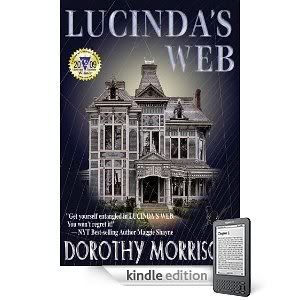Molly Ringwald, the redheaded teen queen of the 1980s John Hughes movies, is handing out advice on parenting, aging and other topics in her self-help book, "Getting the Pretty Back: Friendship, Family and Finding the Perfect Lipstick (It Books, $25.99)," that is on store shelves today. Read the article below to find out more.
But first, take a look at our Featured Sponsor.
Lucinda's Web by Dorothy Morrison
Tess Logan knows magic. She knows how it works, why it works, and what it takes to make it work. But that’s not all. She also knows how to make it happen. It’s simply a part of who she is, for Tess Logan—despite all the other attributes that make her such a thoroughly modern woman—is a thoroughly modern Witch.
No amount of magical experience or expertise, though, could have ever prepared her for this. In fact, she never even dreamed it possible: A living, breathing set of spells cast more than a hundred years ago with enough stamina to follow her into the present day. Yet, here it is, writhing and twisting with activity, permeating every sector of her life, and slipping its tentacles into the lives of everyone she holds dear. Now, she’s faced with having to disentangle each slippery strand and destroy the magic without destroying those she loves—or herself.
No amount of magical experience or expertise, though, could have ever prepared her for this. In fact, she never even dreamed it possible: A living, breathing set of spells cast more than a hundred years ago with enough stamina to follow her into the present day. Yet, here it is, writhing and twisting with activity, permeating every sector of her life, and slipping its tentacles into the lives of everyone she holds dear. Now, she’s faced with having to disentangle each slippery strand and destroy the magic without destroying those she loves—or herself.
Now, I don't read to much fiction but I was pleasantly surprised upon picking up this book. The character of Tess Logan made me giggle out loud nearly at the turn of every page. I very much enjoy the authors books on magick which urged me to get this book. I am very glad I did! I read it the whole way through in just a day or two and and I'm very happy with it.
Molly Ringwald is Now an Author
"Pretty in Pink" Star Publishes Self-Help Book
(CBS) Molly Ringwald, the redheaded teen queen of the 1980s John Hughes movies, is handing out advice on parenting, aging and other topics in her self-help book, "Getting the Pretty Back: Friendship, Family and Finding the Perfect Lipstick (It Books, $25.99)," that is on store shelves today.
Now 42, the mother of three and a star on the teen soap "The Secret Life of The American Teenager," Ringwald has penned a light-hearted look at turning 40 that includes fashion tips, relationship advice and personal anecdotes, though little star gossip.
The former Brat Packer wants every woman who reads her book to become "the sexiest, funniest, smartest, best-dressed, and most confident woman that you can be."
As she dispenses advice on how to do this, Ringwald also looks back on her own life, which included child stardom - her parents got her through that, she said - a period of finding herself in France, a failed first marriage and the difficulties of getting along with a large clan of Greek in-laws. Her husband, Panio Gianopoulos, is a book editor and writer.
Ringwald, who appeared in TV series such as "Diff'rent Strokes" and "The Facts of Life," has dozens of movies to her credit, but she is best known as the star of such John Hughes teen angst classics as "Sixteen Candles" and "Pretty in Pink."
Ringwald belonged to the 1980s' Brat Pack along with Judd Nelson, Anthony Michael Hall, Demi Moore, Rob Lowe, Ally Sheedy, Emilio Estevez and Andrew McCarthy.

